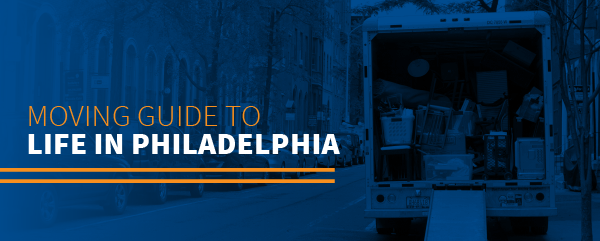Moving Guide to Life in Philadelphia & Movers in Philly
Philadelphia is a growing city. Between 2010 and 2018, thecity’s population grew by nearly 4%. While some of that growth is from births, a lot of it is from people moving into town. Philly has a lot to offer both new and existing residents.
The city is steeped in history, as it’s where the First Continental Congress met and where the Declaration of Independence was signed and read out loud for the first time. Although history is important to Philly, don’t think that the city is stuck in the past. It’s firmly rooted in the present while looking to the future, which makes it an excellent place for anyone to live. If you’re planning a move to or near the City of Brotherly Love, check out this moving guide to Philly for everything you need to know before your move.
The Best Time to Move to Philly
When moving to any major city, considering the time of year can make the process easier. Philadelphia is one of the United States’ most populated cities, and it experiences some of the greatest seasonal weather fluctuations. When you decide to move will significantly impact how easy or difficult the process becomes.
Our Verdict
Considering factors like housing availability, traffic, and weather, the best time of the year to move to Philly is typically the spring and fall months.
What to Know Before Moving to Philly: Overview of Philadelphia Neighborhoods
Wondering where to move in Philadelphia? First things first: Philadelphia is a city of neighborhoods, and each neighborhood has its own distinct vibe and way of life. One way to start understanding what neighborhood is what and where each one is located is to break down the city into geographic sections. The most significant geographic areas are North Philly, South Philly, West Philly, Northeast Philly and Center City — there’s no “East Philly” for whatever reason. Get a sense of the general gist of each geographic area and learn more about some of the neighborhoods you’ll find in each part of the city.
1. North Philadelphia
North Philadelphia is one of the biggest geographic sections of the city. It’s so big that you can divide it into two distinct sections: Upper North and Lower North Philly. There’s also Northwest Philly, which includes areas such as Germantown, Mt. Airy and Chestnut Hill, and Northeast Philly.
Once upon a time, North Philly was an essential player in the manufacturing world. You still see some of the old warehouses and factories throughout the area. The critical difference is that a lot of them have been converted into lofts, apartments or co-working spaces. For example, the site of the former Schmidt’s Brewery in Northern Liberties was converted into apartment buildings. On the ground level of the apartment buildings are retail and dining establishments. The buildings encircle an open area piazza that hosts farmers’ markets, flea markets and other outdoor events throughout the year.
Parts of North Philadelphia are served by the Broad Street line, aka the orange line. The Broad Street line is a subway that runs north-south through the city. Stops in North Philly start at Spring Garden Station and continue every few blocks up to Fern Rock Transportation Center, in Oak Lane.
Other areas of North Philly, such as Fishtown, Northern Liberties and Kensington, are served by the Market-Frankford Line. It’s also known as the blue line or the El —because it’s an elevated train for part of its route. The El runs east-west and then northeast across the city.
Along with having ties to the city’s history and background as an industrial center, North Philadelphia also has plenty of cultural ties. The Philadelphia Museum of Art is located in North Philly, at the top of the Benjamin Franklin Parkway. If you are searching for moving companies in North Philadelphia, contact us!
2. Northeast Philadelphia
Sometimes called the Great Northeast, Northeast Philly almost feels like an entirely different city compared to the rest of Philly. The folks who live there often consider the Northeast as the perfect blend of urban and suburban living.
The hustle and bustle of Center City Philadelphia is just a short car ride (down I-95) or a quick train trip away. Strip malls and shopping plazas offer plenty of conveniences, while the recent influx of people from all over the world means that there is a lot of variety when it comes to dining options.
The Great Northeast is the only area in Philly where you’ll find Georgian — as in the country, not the state — cafes tucked in next to Indian restaurants and places serving pho, a Vietnamese noodle soup, next door to massive Russian supermarkets.
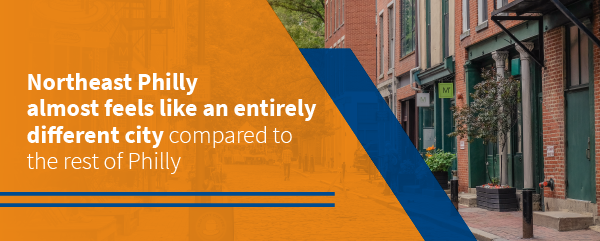
The Northeast has a notable variety of housing stock. Rowhouses are typical there, as they are throughout much of the city. If you decide to move to Philadelphia, you’ll also find your fair share of twins with ample backyards and even suburban-style single-family homes, which are a rarity in much of the rest of the city.
The Great Northeast is, true to its name, a substantial area. Some of the neighborhoods you’ll find up there include Rhawnhurst, Frankford, Pennypack and Byberry. If you are searching for North Philadelphia moving companies, our team can help!
3. South Philadelphia
South Philly was one of the first parts of the city to be settled by Europeans back in the 1600s. Although many people associate parts of South Philly with Italian immigrants, the first Europeans to arrive in the area were from Sweden. The American Swedish Historical Museum, located in FDR Park in South Philly, and neighborhood names such as Queen Village pay homage to the earliest European settlers.
Today, you’ll find a mix of cultures across the geographic area. Italian restaurants and gourmet food stores are found throughout the area, and the Italian Market serves as a nod to the presence of Italian-American families throughout South Philly. But as people from Asia, Mexico and South America have started to call South Philly home, there has been an increase in the number of Latin restaurants and food stores and the number of Asian groceries and restaurants.
South Philly traditions, such as the Mummer’s Parade, which takes place on New Year’s Day, are beginning to reflect the area’s diversity. The annual event is one of the oldest folk traditions in the country. Although traditionally made up of groups of mostly Caucasian men, recent parade participants have been from a wide range of backgrounds.
If you are searching for moving companies in South Philadelphia, we have the help available that you need!
4. West Philadelphia
Located to the west of the mighty Schuylkill River, West Philly is home to several prestigious universities, such as Drexel and the University of Pennsylvania. It’s also the home of 30th Street Station, which is served by Amtrak, NJ Transit and SEPTA.
West Philly is a vast section of the city. The part of West Philly that’s centered around Drexel and UPenn is sometimes called University City. Meanwhile, areas that extend west from there are known as Spruce Hill, Squirrel Hill and Walnut Hill. Keep going west and a bit north, and you’ll come upon Wynnefield Heights, Overbrook and the Centennial District.
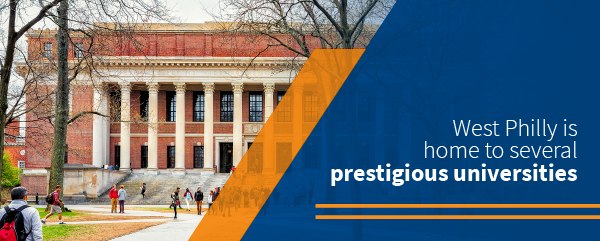
Much of Fairmount Park, the city’s massive park system, is found in the northern section of West Philly. Within the park, you’ll find the Mann Center, which is the Philadelphia Orchestra’s home base during the summer and which also hosts pop-music concerts from May to October. The park is also home to the Please Touch Museum, Smith Memorial Playground and the Philadelphia Zoo.
If you are searching for moving companies in West Philadelphia,we can help!
5. Center City Philadelphia
Center City is a bit of a misnomer, as the downtown part of Philly isn’t exactly in the “center.” Center City stretches east-west from river to river and north-south from South Street to Spring Garden Avenue. Although it’s one of the most touristy areas of the city, plenty of people are proud to call Center City home.
Center City is home to Old City, which is the site of plenty of historical landmarks. You’ll find Independence Hall, the Liberty Bell and the Betsy Ross House in Old City. Along the eastern edge of Old City is the Delaware Waterfront, which is now home to Spruce Street Harbor Park.
Spruce Street Harbor Park is open from May to September each year. It’s full of hammocks for relaxing in. There is a beer garden and lots of vendors selling donuts, ice cream and other eats. Just north of the park is the Independence Blue Cross RiverRink, which is home to ice skating in the winter and roller skating in the summer.
Other areas of interest in Center City include Rittenhouse Square, one of the five public squares planned out by William Penn. Rittenhouse Square is a favorite spot to relax, people watch or catch up with friends. It’s home to a farmers’ market that’s open year-round as well as several arts and crafts fairs throughout the spring and summer.
If you are searching for moving companies in Center City Philadelphia, our experts are happy to assist!
History Is Everywhere: Historical Attractions in Philadelphia
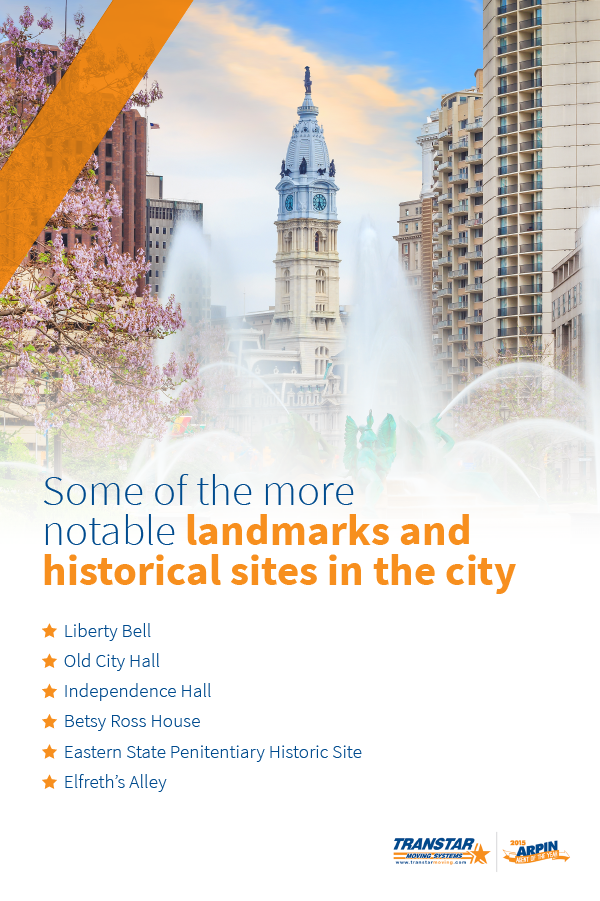
If you may be moving to Philadelphia, it is important to understand a short overview of where you can find the most historical landmarks the city has to offer. Philly was the first city in the U.S. to be named a UNESCO World Heritage City. You can’t go far in Philadelphia without coming upon some reminder of the city’s role in the American Revolution and the birthplace of the U.S. Some of the more notable landmarks and historical sites in the city include:
1. Liberty Bell
When you first arrive in Philly, it’s worth it to pay a visit to the Liberty Bell. Located in Independence National Historical Park, the entrance to the Liberty Bell is at 526 Market — on the southeast corner of 6th and Market. It takes about 15 minutes to walk through the exhibit and see the bell.
One of the most notable features of the Liberty Bell is its crack, but what a lot of people don’t know about it is that the crack as it exists today was part of the repair of the bell. The crack was widened to keep it from spreading more and to improve the bell’s tone.
2. Old City Hall
Old City Hall, located at the corner of 5th and Chestnut Streets in Independence National Historical Park, was built in 1791. During the time that Philly was serving as the capital of the U.S., Old City Hall was where the Supreme Court met.
Today, the building is open to visitors from 9 a.m. until 5 p.m. daily. Admission to Old City Hall is free, and a park ranger is on hand to answer any questions you might have about the building, the furnishings found in it and Philadelphia’s role in the founding of the U.S.
3. Independence Hall
Across the street from Old City Hall is Independence Hall, where the Declaration of Independence and the U.S. Constitution were signed. Independence Hall is open seven days a week, usually from 9 a.m. until 5 p.m. During the summer, it’s open until 7 p.m.
Although it’s free to get into Independence Hall, you do need a ticket for entry. You can either pick up tickets in person the day you plan on visiting — at the Independence Visitor Center, at 6th and Market Streets. The visitor center starts distributing tickets at 8:30 a.m. and gives them out on a first come, first served basis. The earlier you get there, the more likely you are to get tickets.
You can also reserve your tickets online. Booking online lets you choose the time of your visit and guarantees you a spot, without you having to get to the visitor center first thing in the morning. Although online tickets are still free, there is a $1 reservation charge.
If you don’t want to deal with the hassle of getting tickets, you can try visiting Independence Hall after 5 p.m. in the summer months or any time it’s open in January or February.
4. Betsy Ross House
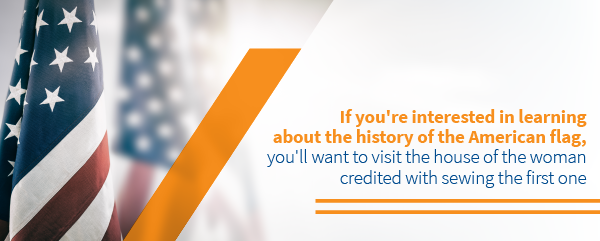
If you’re interested in learning about the history of the American flag, you’ll want to visit the house of the woman credited with sewing the first one. While visiting the Betsy Ross House, you can take a self-guided tour of the home or purchase the audio tour for a few dollars more. After the tour, you can hang out in the house’s courtyard, where concessions are available. It’s also likely that you’ll get to meet Mrs. Ross herself!
The Betsy Ross House is open daily from March through November, then Tuesdays through Sundays in December through February.
5. Eastern State Penitentiary Historic Site
When it was built in the 19th century, Eastern State Penitentiary was one of the most expensive prisons in the country. It was also considered revolutionary, as the goal of the prison was to reform those kept within it through solitary confinement and isolation.
Touring the penitentiary, which is open daily, gives you a glimpse into the lives of the people imprisoned there from the 19th century until the prison closed its doors in the early 1970s. You’ll also get to visit the cells of famous criminals, such as Al Capone.
6. Elfreth’s Alley
Located in Old City, Elfreth’s Alley is the oldest continually occupied residential street in the U.S. People have been calling the houses in the alley home since the 18th century. A stroll down Elfreth’s Alley is like walking into a time capsule. If you’re interested in learning more about the narrow residential street, you can pay a visit to the Museum House, which is open on Fridays and weekends from noon until 5 p.m.
Best Foods to Eat in Philadelphia
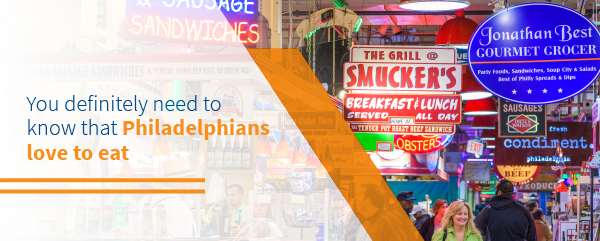
What else should you know about moving to or around Philly? You definitely need to know that Philadelphians love to eat, and more and more people are starting to realize that food in Philly is where it’s at. The Washington Post named Philadelphia a Best Food City, for instance. When you’re starting your food tour of Philly, there is one obvious place to begin: The cheesesteak. Once you’ve mastered the cheesesteak, and found your favorite, you can branch out and start exploring Philly’s other unique eats.
Where to Get to Cheesesteaks in Philly
Ask anyone, and they will say that the only place to get a real cheesesteak is in Philly. They just don’t taste the same anywhere else. And yes, Philadelphians will tell you moving from NJ to Philly solely for the cheesesteaks is worth it.
That said, there’s a lot of debate about where to get the best cheesesteak in the city. You might want to try them all before you settle on a favorite:
- Geno’s. Located on 9th street in the Italian Market in South Philly.
- Pat’s King of Steaks. Located across the street from Geno’s.
- Tony Luke’s. Tony Luke’s has locations across Philly, but its original spot is way down in South Philly, at Front Street and Oregon Avenue.
- John’s Roast Pork. Another South Philly staple, John’s Roast Pork is located just north of the IKEA on Snyder Avenue.
- Jim’s Steaks. Located at 4th and South Streets, you’ll often see the line for Jim’s winding down the block.
- Dalessandro’s Steaks. Located in Roxborough, at 600 Wendover Street, just off of Henry Avenue, Dalessandro’s cheesesteak is the cheesesteak aficionados’ cheesesteak.
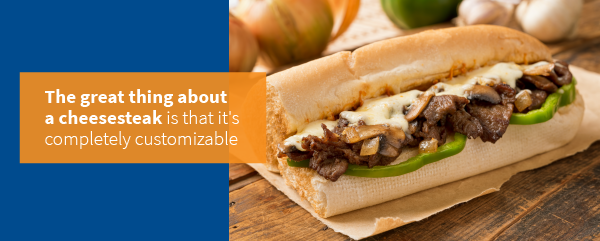
The great thing about a cheesesteak is that it’s completely customizable. You can choose the type of cheese you want, whether you want onions, then add your other toppings. Here’s a basic rundown of how to order your first cheesesteak:
- Say what type of cheese you want on it: Whiz, American, Provolone.
- Say whether or not you want onions: “Wit” or “widout.” For example, if you’re getting onions and cheese whiz, you’d say “Whiz wit.” If you’re getting cheese whiz, no onions, you say “Whiz widout.”
- Add any other toppings: hot peppers, ketchup, tomatoes and so on.
Other “Philly” Foods to Try If You Are Moving to Philadelphia
Once you’ve mastered the cheesesteak, it’s time to sample some of Philly’s other notable foods:
- Scrapple. Trust us when we say that you don’t want to know what’s in scrapple. Also trust us when we say that once you try it, you won’t go back to basic bacon or sausage with your breakfast again.
- Italian Tomato Pie. People who have grown up in the Philly area are often surprised that other people don’t know what tomato pie is. Meanwhile, people who are new to the area are pretty confused about tomato pie. One way to describe it is like a thick crust, square-shaped pizza, minus the cheese. You’ve just got to try it.
- Hoagies. In other parts of the U.S., sandwiches served on long rolls are called subs, in others, they are called grinders. In Philly, they are called hoagies. They’re also called hoagies in some parts of New Jersey and the Philadelphia suburbs.
Cost of Living in Philadelphia – Why Move to Philly?
One of the most important things to know before moving to Philadelphia or its surrounding suburbs is how much your new life in the city is going to cost you. The cost of living varies based on where you end up living. Areas such as the Great Northeast tend to have a much lower cost of living compared to Center City. The average price of housing varies considerably throughout South Philly and North Philly, too.
As you get ready to move to Philly, PA, take a look at some of the costs you can expect:
- Housing. The median home value is $154,000 in the Philadelphia area. Average rents range from $834 for a studio to $1,493 for a three-bedroom.
- Energy Bill. The average cost of energy (gas/electric) in Philly is about $208 per month. Your prices can vary based on the size of your home and how much you use your air conditioner or heater.
- Transportation. A monthly SEPTA Transpass, which is valid on buses, subways and trolleys, is $96. A weekly pass is $25.50.
- Phone/Internet. About $222 per month, although this can vary considerably based on the providers you choose and the type of plan you pick.
How Does Philadelphia’s Cost of Living Compare to the Rest of the U.S.?

Philly isn’t as pricey as some places, like New York, DC or San Francisco. But it’s also not the cheapest place to live. The cost of living index for Philadelphia is 110.8, making it just slightly more expensive than the average U.S. city.
Best Ways to Get Transportation Around Philadelphia and Philly Suburbs
Philly is a pretty easy to place to get around, even if you don’t have a car. If you do have a vehicle, you can park it near your home and leave it there, navigating the city in other ways.
If you want to take public transportation, SEPTA has bus routes throughout the city, as well as several trolley routes in West Philly and its two subway lines, the Broad Street Line and the Market-Frankford El. Regional rail lines will take you out of the city itself and into the Philly suburbs or New Jersey.
Philly is also a pretty bikable city and is becoming even more bike-friendly. Bike lanes have been painted on several streets in town, and there are plans for more. Most notably, several new bike lanes are protected lanes, which helps to make the roads safer for cyclists.
It’s also pretty easy to walk from place to place in Philadelphia. If you’re visiting tourist attractions as you get to know your new home, you’ll find that many are within 15 minutes of each other. As you get settled in your new neighborhood, you’ll likely find that your bank, local market and other places are within a short walk from your home, too.
Moving a Business to Philadelphia
Moving a business to a new city is often complex. Between office furniture, supplies, technology and inventory, your organization has so much to take with it to the new location. Everything has to arrive safely and on time so that your business can continue normal operations as soon as possible. Learn more about each step you can take to successfully move your business to Philly with our online guide, from deciding on your new office space to planning the entire moving process.
Fortunately, there’s a friendly moving company in the Philadelphia area ready to lend a hand. The professional movers at Transtar Moving have the personnel, vehicles and packaging materials needed to move everything in your office to Philly. We’ll use our expertise to ensure everything you need makes it to your new Philly office safely and on schedule.
Benefits of Hiring Professional Movers for Your Philadelphia Move
When moving from South Jersey to Philly, you don’t have to do everything yourself. Whether you’re moving from Berks or Bucks County in PA to Philly or moving from Philadelphia to NJ, hiring a team of professional movers is the way to go.
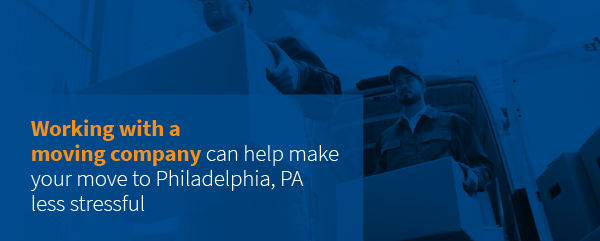
Working with a moving company can help make your move to Philadelphia, PA less stressful. A team of movers that knows how to navigate Philly’s narrow, one-way streets will save you a lot of stress when moving. Pro movers also know the most efficient ways to pack and unload the truck, meaning your move is over sooner and you can begin getting settled in your new home.
If you’re moving to the Philly suburbs, hiring a moving company means you don’t have to worry about navigating traffic in a moving van or truck. You leave the heavy lifting, and driving, to us. Transtar Moving Systems is one of the best moving companies for moving to Center City, Philadelphia, South Jersey and the surrounding areas. Our movers know what routes to take to beat the traffic.
Short and Long Distance Movers in Philadelphia PA
One last reason to work with professional movers for your move to Philly: Your move is guaranteed. Our team of expert movers will treat your belongings like they were our own. We guarantee that everything will arrive at your new place safely and that we’ll put everything in place once we arrive.
As you get ready for your move to Philadelphia, get in touch with Transtar Moving Systems to learn more about how we can help you have the best move possible.

